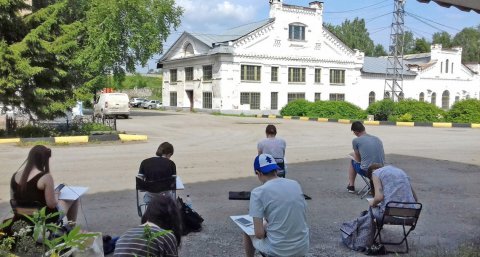Machine Workshop of Nyazepetrovsk Crane Building Plant, being an architectural and town planning monument, has become the main object of studying for a group of nine freshmen students and their lecturer Maria Fedorova.
Focus on Ancient Greece
In the end of the first year of studies students being from program on Design of Architectural Environment undergo educational introductory training at one of historical facilities. This year the Department supervisors have suggested a building of an old factory workshop in Nyazepetrovsk, which is an architectural and town planning monument of the regional significance.
According to the training supervisor, senior lecturer Maria Fedorova, despite the fact that the workshop’s architectural style is quite typical for an industrial construction of a mining area, the building of this workshop is truly unique — it not only preserved well, it is still used in the production process. Majority of similar buildings in the region are already destroyed or re-built so that no trace of the former look is left. The exact year when the workshop in Nyazepetrovsk was built is not known, approximately it dates back to late 18th century, that is the workshop is more than two hundred years old and it is almost of the same age as the city itself.
"Architectural elements of the workshop's facade are a referral to the architecture of Ancient Greece. Square modillions along the cornice are obviously of Ancient Greek origin, the same elements can be seen on ancient temples such as the Parthenon. We can easily explain their presence on the workshop's building: Russian architects learned their profession from classical Greek canons. Inside the workshop features cast-iron columns — these are bearing structures, that is their function is practical, but at the same time they are stylized as classical," shares Maria Fedorova.
The students were offered a task on making drawings of the workshop facade, measure it, as well as цеха, sketch the building and its architectural elements in different techniques: using pencil and water-colour. Every day for five days students spent three hours drawing the workshop from nature, and also using a tape measure they measured its perimeter, and its height was calculated using a special formula. As a result of this practice an album will be made containing full historical information about Nyazepetrovsk, and a detailed architectural description of the workshop. The report will also include all the painting and pencil illustrations made by the students.
Folklore Collection
As part of their cultural program, the guests visited the museum and exhibition center, and the central library, where they purchased books on the historical past of Nyazepetrovsk for the Institute's Department. The students and their teacher were especially impressed by the art school of Nyazepetrovsk Community Center — they were simply delighted to see the high level of works by children, they thought that those were not just interesting, but also one can learn new things from them.
In their free time the group walked around Nyazepetrovsk. Searching for historical sights they strolled away from the center and into old streets, where they hoped to find old merchants' houses, but not one of those were preserved. Students walked along Tverskaya and Gamayuny streets, and climbed Shikhanka mountain.
It was a pleasant surprise for the future designers to see that surprisingly many carved architraves were preserved on the windows of houses, and thanks to that almost every other house has kept its initial individuality, even after windows in plastic frames were installed. The architraves are so colourful and so intricately carved that, according to M.Yu. Fedorova, even if they are put down, one should in no case throw them away; all of such things kept somewhere in the attics should be collected and organized into a museum.
"Nyazepetrovsk has very well preserved provincial atmosphere: the architraves, white curtains, geraniums, and a cat — just a complete folklore set in each window. And what a variety of makes of round and oval shaped forged handles on wooden gates! They also deserve a special exhibition spot in a museum," believes Maria Fedorova.
She and her students liked positively everything about Nyazepetrovsk. When preparing for the trip they collected information about the city, they now and then read about such things as "social ill-being"; but once they arrived there, they saw incredibly beautiful nature, warm welcome, and amiable and friendly people everywhere: on the plant, in the Administration, in the hotel, and on the streets. They say that the city look does not show any obvious lack of amenities, everything is quite decent, and even if there are some small things, then those are nothing but signs of natural course of life.
Of course, there are things throughout the city, which need improvement, as Maria Fedorova believes: the territorial identity of Nyazepetrovsk is not outlined in any way. If the region's authorities are planning on attracting tourists, then they should try to reproduce the spirit of the area, and its cultural and historical specific features. Today every territory is striving to present its uniqueness: in Zlatoust, for instance, it is an outdoor sculpture park Bazhovskiye Skazy (Bazhov's Tales). In Nyazepetrovsk for now this function is being fulfilled only by a wooden bear installed at the city entrance point.




